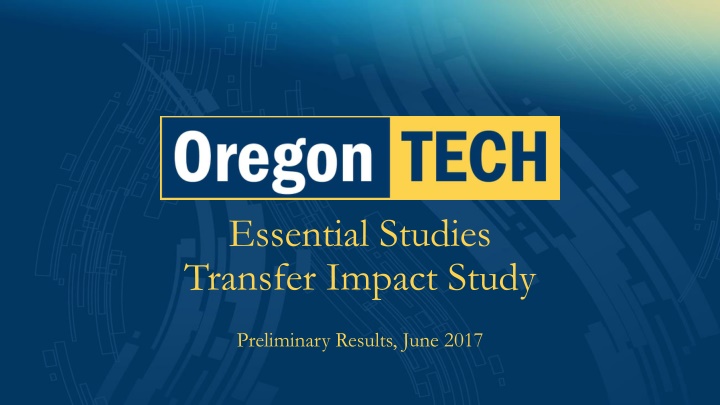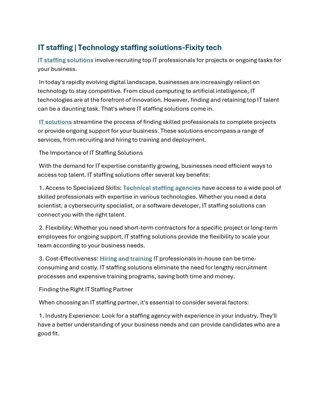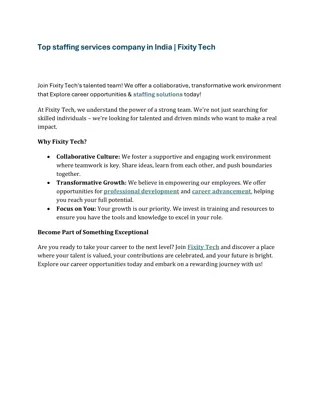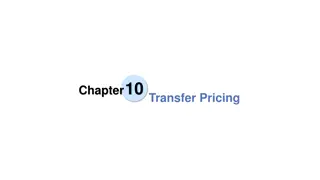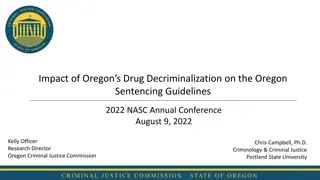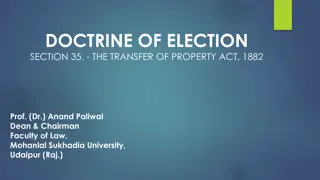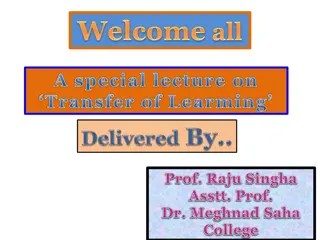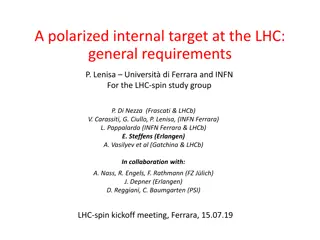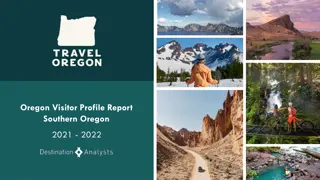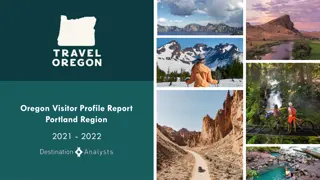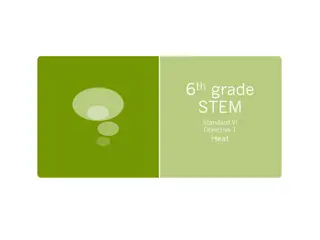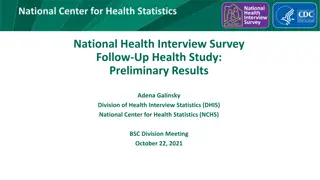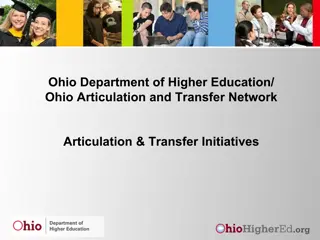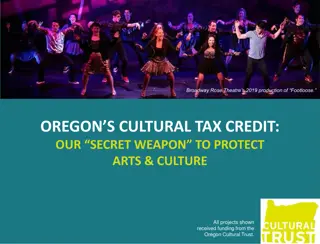Oregon Tech Essential Studies Transfer Impact Study Preliminary Results
Essential Studies at Oregon Tech aim to shape distinctive graduates through a unique general education approach that focuses on producing skilled problem-solvers. The Transfer Impact Study discusses the effects of changes in general education, highlighting both positive and negative outcomes on students' educational experience, success, and workforce readiness. The comparison between the prior general education model and the Essential Studies model showcases the shift towards a more intentional, outcome-aligned curriculum to better prepare students for future endeavors.
Download Presentation

Please find below an Image/Link to download the presentation.
The content on the website is provided AS IS for your information and personal use only. It may not be sold, licensed, or shared on other websites without obtaining consent from the author.If you encounter any issues during the download, it is possible that the publisher has removed the file from their server.
You are allowed to download the files provided on this website for personal or commercial use, subject to the condition that they are used lawfully. All files are the property of their respective owners.
The content on the website is provided AS IS for your information and personal use only. It may not be sold, licensed, or shared on other websites without obtaining consent from the author.
E N D
Presentation Transcript
Essential Studies Transfer Impact Study Preliminary Results, June 2017
Essential Studies: Defining the Oregon Tech Experience Shaping Distinctive Graduates General education that s more than the sum of its parts, that supports success within the discipline and in life, that produces skilled, multifaceted, creative problem-solvers. General education that is uniquely Oregon Tech hands-on, applied, workforce-relevant (and recognizing our mix of students, including transfers)
Transfer Impacts Any changes to any general education will have transfer impacts: - Negative: extra credits/cost/time to degree - Positive: enhanced educational experience (knowledge and skills), greater student success and workforce readiness, distinctive and marketable curriculum elements. (This tension and tradeoff already exists between programs, too.) Impacts should be identified, justified, and minimized iterative testing and refinement of Essential Studies. Transfer was in mind from the beginning.
Prior General Education Model Pros: unusually large buckets makes transfer easy Cons: poor alignment with student outcomes (which are also workforce/employer needs) minimal vertical development, little integration with discipline. 36 M/S or 45 M/S/SS (typically integrated with major requirements) Social Sciences Humanities Communication* *WRI111, 122, SPE111, 321 Math/Science** **1 lab science
Essential Studies Model More intentional (and smaller) bins, aligned with outcomes, reinforced in courses in the major, integrated within & across disciplines. Synthesis Disciplinary Capstone ESSE Program- Integrated Practice Essential Practice Foundation Quant. Literacy Teamwork Communication* *WRI121, 122, SPE111 Diverse Persp. Inquiry & Analysis** **Hum, Soc. Sci, Nat. Sci Ethical Reasoning
Parameters for Transfer Study Fall 16: Vetted by stakeholders (GEAC, Transfer Team, admin) Stratified sampling: 3 groups of 30 each, Fall 16 entering students: Group A (direct from HS, <36 credits, N=157) Group B (transfer, <90 credits, N=178) Group C (transfer, >90 credits, N=381) (Excluded: Postbacs, N=53 separate policy) 90 Student ID s pulled by IR; 2048 transfer courses. Existing degree audits tell us how these courses apply in the major.
Process for Transfer Study Transfer study: How do transfer courses apply under Essential Studies (and how is that different from currently)? To answer this: Every program created a draft curriculum map (first step towards CPC submission); ~2-4 hours/program. Gen ed department chairs evaluated transfer courses under new criteria (helps us develop clear protocols): 4 chairs, ~5-15+ hours each. Assembled, collated, and analyzed data (SA, NS, SB): 60+ hours.
Where are we not applying credits now? 6351.5 credits come in to Oregon Tech; 3091.75 are applied (48.7%) Of the 3200+ credits that not applied: No applicable category in degree map: 1702.2 credits (Vocational: 501 credits; PE: 90 credits) Matches category in model, but block is full: 680.5 credits Remedial: 384+ credits (not counted above) Fractional credit loss: 364.5 credits Below the level required by a program: 230.5 credits Beyond the level required by a program: 165 credits Student has credit for course twice: 82 credits
Group A (Direct from HS) Locations/Modes Klamath Falls (28) Wilsonville (2) Common Transfer Institutions Klamath CC (4) Advanced Placement (4) Southern Oregon U (3) Rogue CC (2) Portland State U (2) Portland CC (2) Eastern Oregon U (2) Chemeketa CC (2) Common Majors Software Engineering Technology (6) Pre-Medical Imaging (5) Biology-Health Sciences (4) Mechanical Engineering (4) Pre-Dental Hygiene (2) Pre-Nursing (4) excluded
Group A (Direct from HS) Average student brings in 16.5 credits. Under old general education model, 8.7 credits (52.5%) applied: Humanities 1.3 credits/9 (0.4 courses/3) Communication (Lower-Division) 1.2 credits/9 (0.4 courses/3) Communication (Upper-Division) 0.0 credits/9 (0.0 courses/3) Social Sciences Math/Science 1.5 credits/12 (0.5 courses/4) 4.1+ credits (1.0 courses+)
Group A (Direct from HS) Average student brings in 16.5 credits. Under Essential Studies, 7.0 credits (42.1%) applied: Foundation Practicing Communication 1.2 credits/9 (0.4 courses/3) - Inquiry & Analysis 1.0 credits/10 (0.3 courses/3) - Quantitative Literacy 0.3 credits/4 (0.1 courses/1) - Diverse Perspectives 0.1 credits/3 (0.0 courses/1) - Teamwork - N/A Ethical Reasoning N/A -
Group A (Direct from HS) Where are losses in transition? (43 credits total; 1.7 credits/student from Group A) Fractional Credit Loss (2 credits) This was mostly hidden fractional loss under old model, too. Carving up Hum block (18 credits) Carving up SS block (17 credits) 2nd year language Credits (6 credits) can apply in Hum Block currently matter for GEAC & ESLO cmtes to consider
Takeaways from Group A HS students seem to be taking college credits opportunistically. GEAC and ESLO committees should consider: - How 2nd year language applies; - How AP courses (and IB) can apply.
Group B (Low-Credit Transfers) Locations/Modes Klamath (20) Wilsonville (4) Online (3) Common Transfer Institutions Portland CC (4) Klamath CC (4) Oregon State U (3) Mt. Hood CC (3) Chemeketa CC (3) Rogue CC (2) Linn Benton CC (2) Eastern Oregon U (2) Clackamas CC (2) Central Oregon CC (2) Common Majors Dental Hygiene (4) Mechanical Engineering (3) Pre-Medical Imaging (4) Pre-Nursing (2) - excluded
Group B (Low-Credit Transfers) Average student brings in 61.5 credits. Under old general education model, 33.5 (54.5%) applied: Humanities 2.2 credits/9 (0.7 courses/3) Communication (Lower-Division) 6.7 credits/9 (2.2 courses/3) Communication (Upper-Division) 1.0 credits/9 (0.3 courses/3) Social Sciences Math/Science 5.5 credits/12 (1.8 courses/4) 8.1+ credits (2.0 courses+)
Group B (Low-Credit Transfers) Average student brings in 61.5 credits. Under Essential Studies, 30.0 (48.9%) applied: Foundation Practicing Communication 6.7 credits/9 (2.2 courses/3) 0.7 credits/3 (0.2 courses/1) Inquiry & Analysis 4.5 credits/10 (1.5 courses/3) - Quantitative Literacy 0.4 credits/4 (0.1 courses/1) 0.6 credits/3 (0.2 courses/1) Diverse Perspectives 0.6 credits/3 (0.2 courses/1) - Teamwork 0.2 credits/3 (0.1 courses/1) N/A Ethical Reasoning N/A -
Group B (Low-Credit Transfers) Where are losses in transition? (84 credits total; 3.1 credits/student from Group B) Fractional Credit Loss (21 credits) Carving up Hum block (14 credits) Carving up SS block (41 credits) Carving up other blocks (8 credits)
Takeaways from Group B Students are being generally strategic about CC courses; this group is the most representative of the breadth of our majors. We should consider: - How to communicate transfer policies to CC students (more detailed transfer website and materials, esp. targeted for Wilsonville, Online, Seattle, Chemeketa) - Relationships with community college advisors/influencers: Thinking about Oregon Tech? Consider these courses (should align with Interstate Passport) - First-year foundational curriculum may be mandated by HB2998.
Group C (High-Credit Transfers) Locations/Modes Klamath (13) Wilsonville (10) Online (6) Chemeketa (1) Common Transfer Institutions Oregon State U (6) Portland CC (5) Lane CC (4) Klamath CC (4) Portland State U (3) Mt Hood CC (3) Clackamas CC (3) Chemeketa CC (3) Western Oregon U (2) Treasure Valley CC (2) Rogue CC (2) Columbia Gorge CC (2) Central Oregon CC (2) Common Majors Mechanical Engineering (5) Radiologic Science (3) Medical Laboratory Science (3) Applied Psychology (3) Technology & Management B.A.S. (2) Dental Hygiene (2) Health Informatics (2) Respiratory Care (2)
Group C (High-Credit Transfers) Average student brings in 146.9 credits. Under old general education model, 67.6 (46.0%) applied: Humanities 6.1 credits/9 (2.0 courses/3) Communication (Lower-Division) 6.9 credits/9 (0.8 courses/3) Communication (Upper-Division) 2.7 credits/9 (0.9 courses/3) Social Sciences Math/Science 8.4 credits/12 (2.8 courses/4) 12.4+ credits
Group C (High-Credit Transfers) Average student brings in 146.9 credits. Under Essential Studies, 60.2 (41.0%) applied: Foundation Practicing Communication 6.9 credits/9 (0.8 courses/3) 1.5 credits/3 (0.5 courses/1) Inquiry & Analysis 7.3 credits/10 (2.2 courses/3) 0.8 credits/6 (0.3 courses/2) Quantitative Literacy 1.3 credits/4 (0.3 courses/1) 1.3 credits/3 (0.4 courses/1) Diverse Perspectives 1.8 credits/3 (0.6 courses/1) - Teamwork 0.6 credits/3 (0.2 courses/1) N/A Ethical Reasoning N/A -
Group C (Direct from HS, N=157) Where are losses in transition? (251 credits loss, 7.4 credits/student net loss from Group C) Fractional Credit Loss (58 credits) Carving up Hum block (69 credits) Carving up SS block (93 credits) Carving up other blocks (24 credits) 2nd Year Language (7 credits) However: also gain of 37 credits mainly from DP and QL slots.
Takeaways from Group C Degree of deliberate course selection here varies widely. (e.g. lots of old credits, lots of discipline switches) We should consider: - What can we recognize from an Associate s Degree? (both an AAOT and a regular AS). - Neighboring states transfer blocks (CA, WA, HI) - Year-long sequences (Essential Practice?) Not included in this group, but: policy for post-bacs (currently, gen ed not prescribed by program is waived)
Impact by Individual Student 20 18 Number of Students BCOM, BSPY Programs with general elective blocks larger than most (already fully filled for these high- credit transfers). 16 14 12 10 8 6 4 2 0 Gains 1 course (2- 4 credits) Neutral (+/- 1 credit or no change) Loses 1 course (2 to 4 credits) Loses 2 courses (5 to 7 credits) Loses 3 courses (8 to 10 credits) Loses 4 courses (11 to 13 credits) Loses 5 courses (14 to 16 credits) Loses 6 courses (17 to 19 credits) Loses 7 courses (20 to 22 credits) Group A Group B Group C
Additional Opportunities Curriculum drafts are not yet optimized. Opportunities to move from prescribing a particular course, now that we have lists aligned with outcomes. Particularly: - Comm Essential Practice (moving away from just WRI227?) - Diverse Perspectives (moving away from just Psych?) - QL-Practice (multiple ways to get econ/finance) Degree audits/transfer database: - Many questions about how catalog is applied in DegreeWorks - Prefix-based transfer categories miss some, and miscount others.
Additional Opportunities Transfer advising: - Consistently reviewing transcripts with advocacy lens. (advising resources and support for each location/mode?) - Giving students tools to self-advocate and take responsibility (which also educates about outcomes and empowers students!) - Mandating student figure out transfer applicability sooner (first two terms in program?), rather than just before grad date.
Conclusion Essential Studies Model does what it set out to do make general education more deliberate, focused, and aligned with outcomes. Where it has impacts, we can understand why, and those impacts support student success. Still a number of opportunities: - GEAC/ESLO policy questions: (languages, sequences, Associates, Post-Bacs) broad lens for applicability of courses, esp. in foundation. - Curriculum maps (justify why a particular course) - Degree audits/transfer database (updated in transition) - Communication with prospective students and CCs.
Some Next Steps - Are there other questions we can/should answer with this data? (This is a rich and interesting data set!) - Policy for GEAC and ESLO committees to consider. - Move to second draft of curriculum maps (conversations beginning over summer). - Follow-up discussions on technical implementation (DegreeWorks and transfer database) with registrar. - Plan alignment with SEM and OAA activities for CC-relationship building (great alignment with HB2998!)
